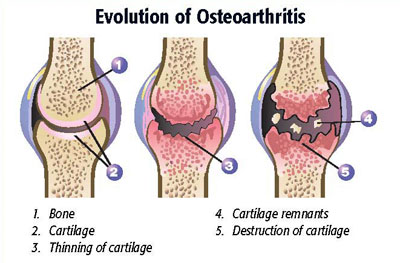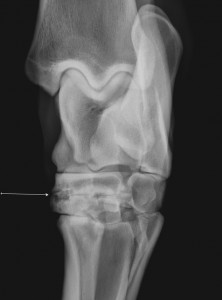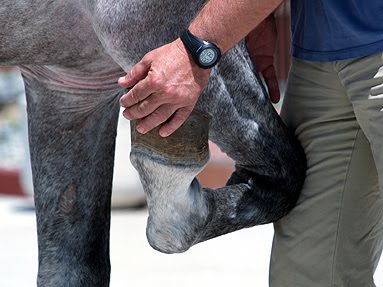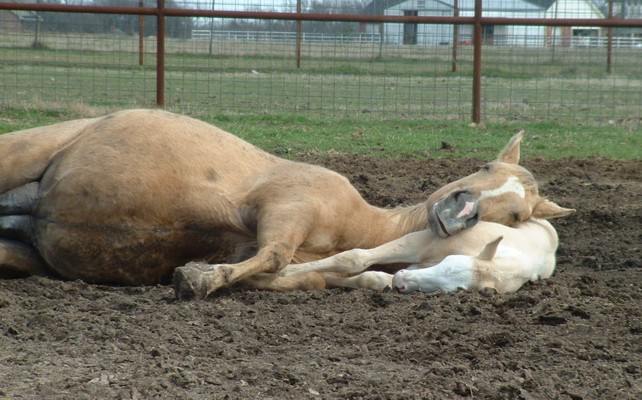Osteoarthritis (bone and joint inflammation – we’ll call it OA, so I don’t have to type out the entire word each time) represents the end of many horses’ athletic careers. The destruction of bone and joint causes pain; as a result, affected horses cannot trot or canter (or occasionally even walk) without limping. When recognized in individual joints, OA is so well-known that it’s even been given specific names, e.g., “ringbone” when it’s seen in the pastern (from the “ring” of bone around the joint that can be seen in more severely affected cases), or “bone spavin” when it’s seen in the hock (“spavin” apparently comes from a Middle French verb meaning, “to hop like a sparrow,” which, if you’ve ever seen a severely affected horse, is right on).
A joint is where two bones meet; the ends are covered with cartilage, which provides a smooth, almost frictionless, gliding surface. Inflammation (the “-itis” in arthritis) releases chemicals that breakdown the cartilage. As the cartilage is destroyed, the underlying bone becomes involved in the process. When bone becomes inflamed, it produces more bone (which is one reason why fractures can heal). And when bone is produced in a joint, movement becomes restricted, and painful.
OA is a huge problem in medicine of *any* species. Medicine’s biggest questions include, “Why do bones and joints deteriorate in some individuals?” In osteoarthritis, there is a complex interaction between the tissues of the joint that plays a significant role in starting, and/or continuing, the disease. No one completely understands all the factors that are responsible for starting the breakdown and loss of the joint tissues. Because no one can answer the first question, the second obvious question, “What can be done about it?” has no “right” answer, either.
In some cases, there are hints to answers for the first question. Trauma, infection, and inflammation in joints can lead to breakdown of the joint tissues, especially the cartilage that covers the ends of the bones.
In some cases, however, OA develops for no apparent reason. While we can understand how a joint that gets infected develops arthritis, some horses develop it for no apparent reason. It’s maddening, actually. If all horses who jumped high fences developed OA, you might be able to understand that jumping high fences causes trauma, trauma causes joint breakdown, and joint breakdown results in OA. But the fact is, all jumping horses *don’t* develop OA – there must be some factor(s) in certain individuals that cause the problem.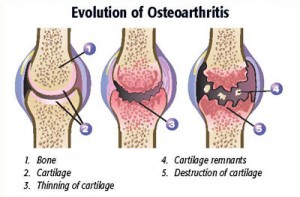
OA is usually recognized when horses being to limp, or perform poorly. Early cases may be identified by thorough physical examination, anesthesia of affected joints (a “joint block”), and/or X-rays. Identification of the problem is often the easy part – what’s hard is figuring out what to do about it.
I’m going to let you in on a little secret. Once OA has developed, there is nothing – NOTHING – that can be done that has been shown to reverse, or even control, the process. That’s right. No supplement, no drug, no injection, no device (shockwave, magnets, special horseshoes, etc.), can make a joint with OA normal. I mean, think about it. If someone could cure arthritis, that person would make Bill Gates look like a pauper! If there were a cure, why are there so many different treatments? If there were a cure, there would only be one treatment, and everyone would use it (like, say, antibiotics for bacterial infections).
Since there’s no cure, treatment of horses with OA is aimed at trying to make the horse as comfortable as possible, for a long as possible. Depending on the severity of the problem, proven effective treatments might include anti-inflammatory and pain-relieving drugs (e.g., phenylbutazone, “bute”), injections of various anti-inflammatory substances directly into the joint, reduced intensity of exercise, and, in overweight horses weight loss. For most horses, light exercise is also helpful – just about anyone who has experienced a sore or stiff joint knows that one way to feel better is go get (and keep) moving.
Of course, just because there is no cure doesn’t mean that people won’t try just about anything. Veterinarians are employed to cure horse problems, and not having a cure can be very frustrating for all involved. Thus, any number of unproven, implausible – and sometimes very expensive – “options”. These would include myriad supplements, stem cells, “shock wave,” magnets, various pharmaceutical products, etc., etc. All of them offer lots of hope and promise – none of them currently have good evidence that they actually do anything for the horse.
OA does not necessarily mean that your horse’s career is over, but it might mean that you (and your horse) have to learn how to best live with the problem. Given that horses don’t complain, and try to do the best they can with what they have, that’s sometimes easier for the horse than it is for the owner! Check out the pages under “Lameness Therapeutics” for lots of information about treatments that may be available for horses with OA.
UPDATE 7/22/11 – STEM CELLS UNLIKELY TO HELP OSTEOARTHRITIC JOINTS. CLICK HERE for more information.

